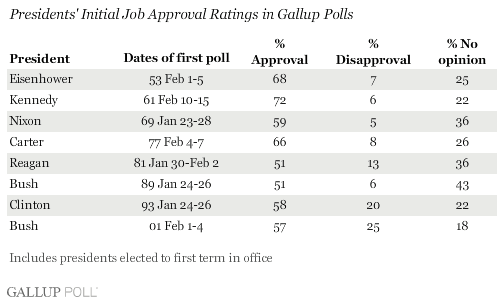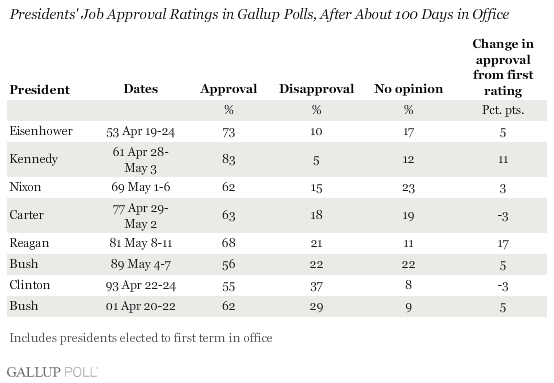PRINCETON, NJ -- Barack Obama can expect to receive a rating above 50% when Gallup reports his first job approval rating this weekend. All elected presidents since Dwight Eisenhower began their terms in office with approval ratings above 50%, generally low disapproval ratings, and high "no opinion" levels.

The public is generally warmly disposed to newly inaugurated presidents, but a substantial proportion of Americans typically await more information to form their initial judgment. Thus, the no-opinion levels have ranged from a low of 18% for George W. Bush to a high of 43% for George H.W. Bush. The percentage of Americans with no opinion of a president is usually much lower after his first year in office.
The percentages approving of newly inaugurated presidents have ranged from a low of 51% for Ronald Reagan in 1981 and the elder George Bush in 1989 to a high of 72% for John Kennedy in 1961. The average across the last eight elected presidents is 60%.
The three presidents who took office after the death or resignation of their predecessors tended to start out with even greater public support, as the nation rallied around the new chief executive in times of crisis. These include Harry Truman in 1945 with an 87% approval rating, Lyndon Johnson with 78% in 1963, and Gerald Ford with 71% in 1974.
One complicating factor in comparing initial approval ratings for the elected presidents is differences in the timing of the first measurements. The four presidents whose first readings came in January after their inaugurations averaged 55% job approval and 34% no opinion, compared with an average approval rating of 66% and 23% no opinion for the presidents whose first ratings came in February, after they had been in office a bit longer.
But these timing differences hint at the general trend in early approval ratings for elected presidents: as people become more familiar with the presidents and their work over the course of the first several months in office, the already-high percentage approving usually increases. In fact, all but Bill Clinton and Jimmy Carter had higher approval ratings about 100 days after taking office. That is why the early months of new presidencies are commonly known as "the honeymoon period."

Obama's First Evaluation
In addition to the track record for past new presidents, Obama's high pre-inauguration confidence and favorability ratings suggest his initial approval rating will be quite positive.
One thing to watch will be Obama's initial disapproval rating. New presidents' disapproval ratings have historically been in the low single digits, but the last two presidents have each had initial disapproval ratings of 20% or higher.
That may reflect some lingering ill-will toward each from their opponents after contentious election campaigns and, in Clinton's case, some early controversy over his nomination of Zoe Baird as attorney general and his attempts to change the military's policy on gays.
In the first few days after Clinton took office in 1993, 41% of Republicans disapproved of the job he was doing. And in early February 2001, 46% of Democrats disapproved of the job George W. Bush was doing. So for these presidents, supporters of the opposing party did not accord them much of a honeymoon.
Obama may be able to reverse this recent trend given the perception that he is a politician who can bring people together. In a recent USA Today/Gallup poll, 80% of Americans described him as a "uniter" and only 16% as a "divider."
Gallup began tracking Obama's approval rating after his first full day in office on Wednesday, and will report an updated three-day average daily on gallup.com, beginning Saturday.
